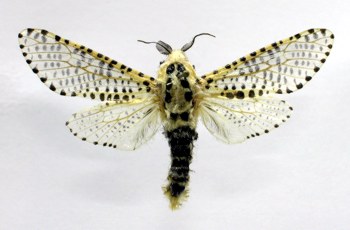Pests
Zeuzera pyrina L. - Wood Leopard Moth
Systematic position.
Class Insecta, order Lepidoptera, family Sossidae, genus Zeuzera.Biological group.
This is a polyphagous pest of many fruit cultures and foliaceous trees.Morphology and biology.
Fore and hind wings white, fore ones with numerous dark-blue oval spots (male wingspan 36-45 mm, female wingspan 50-70 mm). Similar spots are located on notum; abdomen dark-blue, with white rings. Female antennae covered with white pubescence, male ones plumose in basal half. Eggs are light yellow. Caterpillar is yellow, older ones are yellowish-pinkish, on each segment having black points bearing short hairs. Pupa reach 30 mm, dark-brown, cylindrical, with corniculate process between eyes. Hatched caterpillars keep together, plaiting themselves with silk curtain, the next day penetrating into leaf petioles and thin shoots. In 5-7 days they molt for the first time, passing from thin branches into thicker ones. In 9-12 days 2nd molt, in 18-21 days 3rd molt occurs. 3rd-6th instar larvae winter for the first time; 7-8th instar caterpillars winter for the second time. Majority of caterpillars of the second year of life penetrate into wood of trunk. Before pupation the caterpillar makes a single horizontal hole to the trunk surface and gnaws through bark, remaining thin layer; the opposite end of hole is plugged with wood dust. She expands the remote part of the hole, making a chamber that is 6-10 cm long and plaits a thin silk cocoon. Development of pupa lasts 2 weeks on the average. Female lays 500-2000 eggs in 2-6 batches on young shoots, in branch forks, bark cracks, but frequently on the ground.Distribution.
The species inhabits Middle and Southern Europe, Southeast Asia, the Mediterranean, Northern America (adventive). In the former USSR it is distributed in the European part from the Caucasus to northern border of distribution of deciduous forests, in Transcaucasia, Western Siberia, Northern Kazakhstan, in southwest Turkmenistan, in the south of the Far East; in mountain areas it reaches the upper border of forest.Ecology.
One generation develops in 2-3 years. Caterpillars renew feeding in spring at average daily air temperature 10°C which coincides with flowering of fruit trees. Young caterpillars migrate passively on silk threads a large distance with the help of wind. In Crimea the caterpillars hatched at the end of May develop over 4-4.5 months, wintering during the 6th instar; the caterpillars hatched in the beginning of September winter during the 3rd instar. In Crimea their migration from new shoots to 2-7-year old branches occurs at the end of August or in the beginning of September. Caterpillars travel along the surface of branches and trunk and search another place for introduction at night and early in the morning at high air humidity. Pupation of caterpillars of 2nd year of life begins in Ukraine in the last 3rd of May or in the beginning of June at Degree Days 168°, moth flight and oviposition occur in mid-June at Degree Days 350°. Imagoes appear in middle belt of the European part from the end of May until mid-August; in Crimea, Abkhazia, and Adzharia from the end of April until July; in Georgia, Armenia and Primorskii Territory from mid-June until the beginning of September; in Turkmenistan from the end of May until September. Moths fly at twilight and at night.Economic significance.
The species is a secondary pest occupying weakened trees and bushes of more than 70 species. Caterpillars cause damage to branches and trunks of fruit cultures, such as plum, pear, apple; grapes, European olive, currant; also ash-tree, elm, beech, oak, willows etc. Affected branches and trees are distinguished by brownish leaves, drying tips of shoots, and characteristic red-brown frass accumulating at trunk base. Ventilating apertures, through which the excrements are thrown out, and flight apertures with projected exuviae are well visible on branches. In areas of high damage it is possible to find as many as 50 apertures per 1 m of fruit branches. The branches pierced by holes fructify badly, become fragile, and easily break off with wind.Control measures.
Agronomical measures include: cutting and burning of big damaged branches. Chemical measures include: treatment of fruit trees by intestinal insecticides in spring before flowering for destruction of migrating caterpillars of the 1st and partly in the 2nd year of life; the subsequent treatment during hatching of caterpillars conterminous with the control of 2nd generation of the Codling Moth (at Degree Days 485°); priming of holes with cotton wool balls treated with insecticides.Reference citations:
Chistyakov Yu.A. 1988. Cossidae. In: Kirpichnikova V.A., Ler P.A., eds. Butterflies - pests of the Far Eastern agriculture. Keys. Vladivostok: DVO AN SSSR. 55-60 p. (In Russian)Rudnev D.F. 1974. Cossidae. In: Vasil.ev V.P., ed. Pests of agricultural crops and forest plantations. V. 2. Arthropods. Kiev: Urozhai. 226-228 p. (In Russian)
Savkovskii P.P. 1976. Atlas of the pests of fruit and berry plants. Kiev: Urozhai. 207 p. (In Russian)
Vasil.ev V.P., Livshits I.Z. 1984. Pests of fruit crops. Moscow: Kolos. 399 p. (In Russian)
Zagulyaev A.K. 1994. Cossidae. In: Kuznetsov V.I., ed. Insects and mites - pests of agricultural plants. V. 3(1). Lepidoptera. St. Petersburg: Nauka. 47-51 p. (In Russian)


